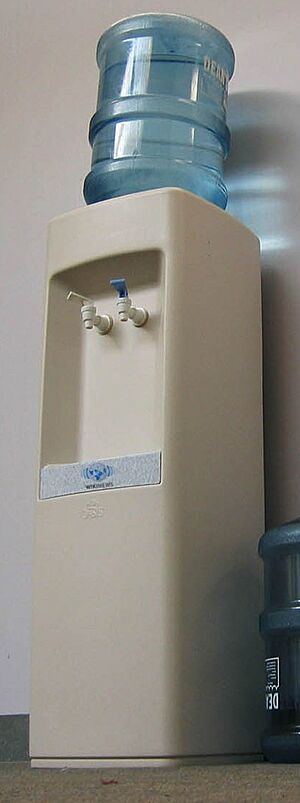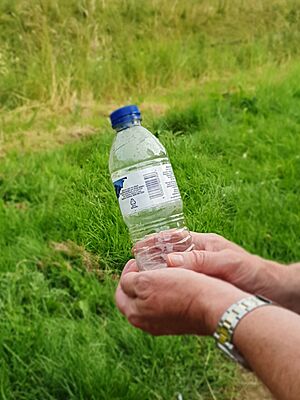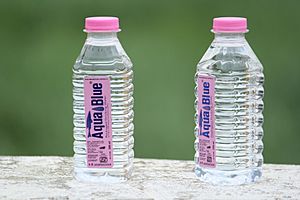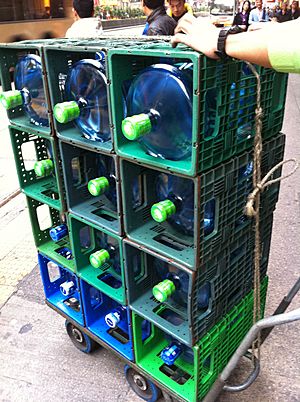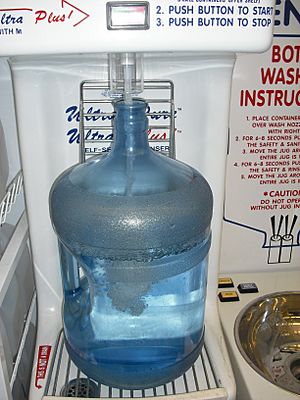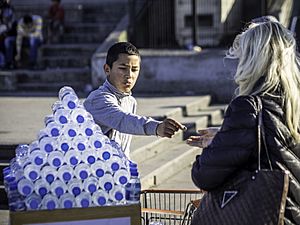Bottled water facts for kids
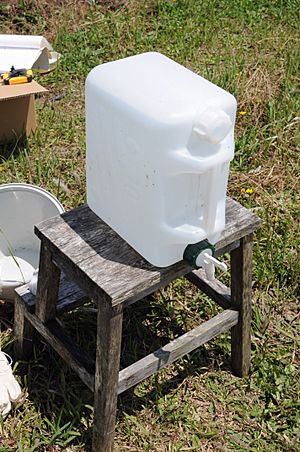
Bottled water is drinking water that comes in plastic or glass water bottles. This water can be from a well, be distilled water, mineral water, or spring water. It can also be bubbly (carbonated) or still. Bottled water comes in many sizes, from small bottles for one person to large containers called carboys for water coolers.
Contents
- The Story of Bottled Water
- Different Kinds of Bottled Water
- How Bottled Water is Sold
- Recycling PET Plastic Bottles
- Water and Energy Used to Make Bottled Water
- Rules and Regulations for Bottled Water
- Bottled Water Around the World
- Information for Consumers
- Being Ready for Emergencies
- Things to Think About with Bottled Water
- See also
The Story of Bottled Water
People have used containers to carry water for a very long time. But bottling water to sell started in the United Kingdom in 1622 at a place called the Holy Well. Bottled water became popular because many people in Europe and America in the 1600s and 1700s started visiting spas and trying "water therapy." They believed the water from these mineral springs could help them feel better.
One of the first bottled waters sold widely was 'Bristol Water' from the Hotwells spa. A writer named Daniel Defoe noted in 1724 that Bristol had many glass factories making bottles to send this water "all over the world."
The first bottled water sold in America was from Jackson's Spa in Boston in 1767. People thought these spa waters had special healing powers.
How Bottled Water Became Popular
Soon, people wanted to make water that tasted like the naturally bubbly spring water. So, carbonated waters were invented. In 1809, Joseph Hawkins got the first U.S. patent for "imitation" mineral water.
In the 1800s, new technology made glass cheaper and bottling faster. This meant bottled water could be made and sold much more easily. Many people felt bottled water was safer than city water, which could spread diseases like cholera and typhoid. By 1850, Saratoga Springs, a popular bottler in America, was selling over 7 million bottles of water each year.
In the early 1900s, bottled water became less popular in the United States. This was because cities started adding chlorine to tap water, making it safer to drink. However, bottled water stayed popular in Europe and spread to cafes and grocery stores. In 1977, Perrier water, which had been bottled since the 1800s, started selling in the U.S. Today, bottled water is the second most popular drink in the United States, after soft drinks.
The Science Behind Water
Studying natural mineral waters helped a lot in the early days of chemistry. Scientists tried to copy these waters to sell them. Joseph Priestley, who discovered oxygen, first contributed to chemistry by dissolving carbon dioxide in water. He later worked with Johann Jacob Schweppe, who started Schweppes, to make "bubbly" waters for sale.
PET Plastic Bottles: A Game Changer
In 1973, a DuPont engineer named Nathaniel Wyeth invented PET plastic bottles. These were the first plastic bottles strong enough to hold bubbly drinks. Today, PET plastic is used more than glass for single-serving bottled water. This is because it is lighter and doesn't break easily.
Different Kinds of Bottled Water
Here are some common types of bottled water:
- Alkaline water – This water has higher pH levels, made using a process called electrolysis.
- Artesian water – This water comes from an underground layer of rock (aquifer) where the water level rises above the top of the aquifer when tapped.
- Fluoridated water – This water has added fluoride. This includes water labeled "For Infants" or "Nursery."
- Groundwater – This water comes from an underground source that is under pressure.
- Mineral water – This water comes from a mineral spring and naturally contains different minerals, like salts and sulfur compounds. No minerals can be added to this water.
- Purified water – This water has been cleaned by processes like distillation, deionization, or reverse osmosis. It can also be called "demineralized water."
- Sparkling water – This water naturally contains carbon dioxide from its source. The carbon dioxide might be removed and put back in after treatment.
- Spring water – This water comes from an underground place where water naturally flows to the Earth's surface.
- Sterile water – This water meets special cleanliness rules, like those in the United States Pharmacopoeia.
- Well water – This water is taken from a hole dug or drilled into the ground.
How Bottled Water is Sold
The bottled water market includes water sold in stores, large containers for homes and offices, vending machines, and imported sparkling water. It does not include flavored or enhanced water.
Water Vending Machines
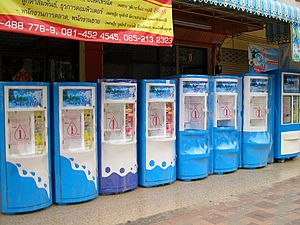
Many cities and companies around the world have vending machines that give out purified water. Customers bring their own containers to fill. These machines filter the local tap water. In North America, you often find them outside supermarkets.
Bottled Water Delivery Services
Many businesses and people get bottled water delivered to them. These services bring water monthly, weekly, or even daily. In the past, glass jugs of water were delivered for electric coolers in offices without plumbing. Now, plastic containers are more common.
Storing Bottled Water Safely
Bottled water is often kept as part of an emergency kit for natural disasters. The U.S. Federal Emergency Management Agency (FEMA) says store-bought bottled water is the "safest" and "most reliable" drinking water source. Experts suggest storing about 1 gallon (3.8 liters) of water per person per day for at least three days. This amount is for drinking, cooking, hand washing, and personal hygiene. Unopened and undamaged factory-bottled water can last a very long time. The "sell-by date" is just a suggestion from manufacturers for when the water will taste freshest, not when it becomes unsafe.
Recycling PET Plastic Bottles
The most common plastic for single-serving bottled water in the U.S. and Europe is polyethylene terephthalate (PET). This plastic is marked with the recycling code "1" and is 100% recyclable. In 2014, about 1.8 billion pounds of used PET bottles were collected in the U.S., and 1.75 million metric tons (about 3.9 billion pounds) in the European Union. This makes PET the most recycled plastic in both regions.
Recycled PET plastic is used for many things, including:
- New bottles and packaging.
- Sheets and films for things like food containers.
- Strapping.
- Special plastics for engineering.
- Fibers for clothing or carpets.
In Europe, over a third of recycled PET is used to make polyester fibers. Another quarter is used for plastic containers like egg cartons and fruit boxes.
Water and Energy Used to Make Bottled Water
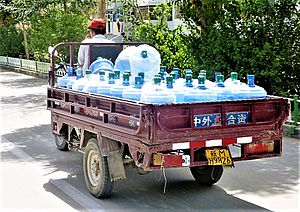
On average, it takes about 1.32 liters of water to make 1 liter of bottled water. This includes the water in the bottle and water used for cleaning and bottling. Facilities that make small bottles (8 oz. to 2.5 gallons) use the least water.
Bottled water uses less water to produce than soft drinks (2.02 liters per 1 liter), beer (4 liters per 1 liter), and wine (4.74 liters per 1 liter). This is because soft drinks, beer, and wine need more ingredients and processing. In the U.S., bottled water production uses only about 0.011% of the country's yearly water.
Making, packaging, and transporting bottled water in the U.S. uses about 0.07% of the country's yearly energy. It also creates about 0.08% of the yearly CO2 equivalent emissions. A study in 2015 found that each liter of bottled water needs 240 kilojoules of energy to produce. A half-liter PET plastic bottled water creates 111 grams of CO2 equivalent. A soft drink bottle of the same size creates 240 grams of CO2 equivalent because it needs thicker plastic for carbonation.
Rules and Regulations for Bottled Water
Different countries have rules for bottled water to make sure it is safe and properly labeled.
In the United States
The U.S. Food and Drug Administration (FDA) regulates bottled water as a packaged food. FDA rules for bottled water must be at least as strict as the Environmental Protection Agency (EPA) rules for tap water.
The FDA has "Standards of Identity" for bottled water. To be called "bottled water," it cannot have sweeteners or chemical additives (except small amounts of flavors from spices or fruit). It must also be calorie-free and sugar-free. The FDA also sets limits on how much fluoride can be added. "Mineral water" must have at least 250 parts per million of dissolved minerals. "Purified water" has its own definition in the United States Pharmacopoeia.
In Australia and New Zealand
The Food Standards Code in Australia and New Zealand limits fluoride in bottled water to between 0.6 and 1.0 milligrams per liter. Any added fluoride must be on the label.
In the European Union
Directive 2009–54/EC sets rules for selling natural mineral waters in the European Union. The two main types are mineral water and spring water.
"Mineral water" is groundwater that comes from the ground and flows over rock. It can only be treated to remove unstable elements like iron and sulfur compounds, usually by filtration or decanting with oxygen. Removing or adding carbon dioxide has strict rules. It is completely forbidden to disinfect natural mineral water or add anything that changes its natural bacteria. If mineral water is bubbly, its label must say why: naturally carbonated, fortified with gas from the spring, or carbonated (CO2 added).
Bottled Water Around the World
Global Sales
In 2014, people around the world drank over 3 billion hectoliters of bottled water. In 2017, consumption grew by about 7.6%. Each person drank an average of 50.1 liters, up from 47.1 liters in 2016.
Australia
The bottled water industry in Australia is worth about $400 million each year. One fancy restaurant in Sydney stopped selling bottled water and now uses a machine to filter, chill, and carbonate tap water to get the same quality.
India
The bottled water industry in India grew quickly in the late 1990s after Bisleri launched its packaged drinking water. This growth was helped by lots of advertising saying "bottled water was pure and healthy."
In 2013, the market was worth 60 billion Indian Rupees. The top five companies (Bisleri, PepsiCo, Coca-Cola, and Parle) made up 67% of the market. This market is expected to grow to 160 billion Indian Rupees by 2018.
In 2016, the state of Sikkim banned plastic water bottles and styrofoam products at government events because of health and environmental concerns.
Lebanon
Lebanon has one of the fastest growing rates of bottled water use per person. Lebanon has seven main brands of bottled mineral water. They sell it locally and export it to countries in the Arabian Peninsula and Persian Gulf that need water.
New Zealand
Bottled water in New Zealand must follow the rules in the Food Act 1981. Since July 2009, fluoride is allowed in bottled water, either added or naturally present.
Pakistan
Because tap water is often contaminated in Pakistan, many families started using water filters or getting mineral water delivered. Large 1-gallon bottles that attach to dispensers are still very common.
Nestlé made bottled water famous in Pakistan with a huge marketing campaign. Other brands include Coca-Cola, Pepsi, and many local ones.
United States
The U.S. is the second largest market for bottled water in the world, after China. In 2016, bottled water sales (by volume) were higher than carbonated soft drinks, making it the number one packaged beverage in the U.S. In 2018, Americans drank 14 billion gallons of bottled water, with each person drinking about 41.9 gallons a year.
The number of mineral water brands in the U.S. has grown a lot, from 16 brands in 1970 to 195 brands in 2012.
Information for Consumers
Labeling Rules
In the United States, the FDA sets rules for all packaged foods and drinks, including bottled water. Labels must state the type of water, follow FDA definitions, list ingredients, show the manufacturer's name and address, and include net weight.
Comparing Bottled Water and Tap Water Information
Public water systems in the U.S. must give households a Consumer Confidence Report (CCR) each year. This report tells people about the quality of their tap water. The FDA does not require such reports for bottled water. However, all packaged foods and drinks, including bottled water, must be made following FDA rules and meet all quality and safety standards.
In Canada, bottled water is considered a food and must meet the standards in the Food and Drugs Act & Regulations (FDAR). The FDAR works with Health Canada to create policies for bottled water. The Canadian Food Inspection Agency (CFIA) focuses on rules for packaging, labeling, advertising, and safety. The FDAR focuses on the water itself. For example, bottled water must meet CFIA rules in Division 12, Part B of the Act before it can be sold. These rules cover labeling, safety standards, and bacteria limits. Labels must also show the filtration method used.
In Canada, there are two types of bottled water: 1) spring/mineral water, or 2) other water. Spring and mineral water must come from an underground source not connected to a community water supply. It must also be naturally safe to drink at the source and not be treated in a way that changes its original chemical makeup.
Being Ready for Emergencies
Being ready for emergencies means taking steps before a natural disaster to stay safe. The American Red Cross and FEMA suggest that families have emergency kits. These kits are helpful if a disaster cuts off food or water, blocks roads, or makes it hard to find basic needs. After disasters like floods or earthquakes, water sources can be cut off or become unsafe.
FEMA suggests that emergency kits include 1 gallon (3.8 liters) of water per person per day for at least three days. This is for drinking and cleaning. In hot places, FEMA suggests doubling this amount. For water, FEMA recommends commercially bottled water stored in a cool, dark place. Another option is to use clean, food-grade containers to store tap water and change the water every six months.
Water Contamination Example
In August 2014, officials in Toledo, Ohio, banned local tap water. This happened because toxins from algae in Lake Erie were found in the city's water supply. The American Red Cross and AmeriCares helped give out bottled water to the 500,000 people affected by the ban.
Things to Think About with Bottled Water
Most bottled water containers are made from recyclable PET plastic. However, some of these bottles end up in landfills. The cost and environmental impact of transporting bottled water are also concerns. This is because of the energy used and the carbon dioxide released, which can affect climate change.
People buy bottled water for many reasons, including taste, convenience, worries about tap water quality and safety, health concerns, and as a replacement for sugary drinks. The environmental impact, bottle safety, where the water comes from, and its role in emergency supplies are all things many people worry about.
Sometimes, bottled water is actually tap water. However, in some places, the quality rules for bottled water are stricter than for tap water. In the U.S., bottled water that comes from city water supplies must be clearly labeled unless it has been processed enough to be called "distilled" or "purified."
One study in America showed that even in areas with safe tap water, African American and Latino parents were three times more likely to give their children mostly bottled water than white parents. They believed bottled water was safer, cleaner, tasted better, or was more convenient. This also showed money differences: white families spent about 0.4% of their income on bottled water, while African American and Latino families spent more than twice that. The study noted that for poorer families, spending on bottled water might mean less money for other health needs.
Globally, bottled water sales are growing fast in poorer developing countries. This is due to fears of "contaminated tap water, poor city water systems, and more marketing from bottled water companies." Sales are rising sharply in Mexico, China, and parts of India.
How People See Bottled Water
Many people think bottled water is safer than other water sources like tap water. Bottled water use has increased even in countries with clean tap water. This might be because people don't like the taste of tap water or how it feels. Successful marketing has also played a role. For example, Perrier turned a bottle of water into a status symbol.
However, the bottled water industry spends much less on advertising than other drinks. In 2013, bottled water spent $60.6 million on advertising, while sports drinks spent $128 million, sodas spent $564 million, and beer spent $1 billion.
Consumers often choose bottled water for health reasons. In places with tap water problems, bottled water use is much higher. The International Bottled Water Association says bottled water companies cannot compare their product to tap water in their ads. Consumers are also affected by memories of brands. For example, Coca-Cola removed its Dasani product from the UK market after finding too much bromate, and people linked this problem to the Dasani brand.
Some studies found that bottled water is often consumed as a replacement for alcoholic and sugary soft drinks, not just tap water. Another reason for its popularity is that drinking "pure" and "natural" bottled water in polluted areas might feel like a way to cleanse oneself.
Many low-income families avoid tap water because they fear it might cause sickness. In the United States, bottled, filtered, and tap water are mostly safe. The EPA rules for tap water are actually stricter than the FDA rules for bottled water. A study in Cincinnati, Ohio, found that bacteria counts in bottled water were often higher than in tap water, and fluoride levels were not consistent.
Globally, there is a growing environmental concern about bottled water. Environmental groups like the World Wide Fund for Nature (WWF) and Greenpeace warn about the huge environmental footprint of the plastic bottles. In 2001, a WWF study said that in many countries, bottled water might not be safer or healthier than tap water, but it costs up to 1,000 times more. It warned that the growing market would put pressure on plastic recycling and could fill landfills with plastic bottles. The study also found that making bottled water uses more water than the amount of water actually in the bottle.
Cost of Bottled Water
Bottled water costs more than tap water. Tap water comes from fixed sources and pipes, while bottled water is sold at many different prices and in various sizes.
In the U.S., bottled water sales tripled to about $4 billion a year in the past decade. More than 50% of the U.S. population drinks bottled water. People spend 240 to over 10,000 times more per gallon for bottled water than for tap water. An annual supply of bottled water for someone drinking 8 glasses a day would cost about $200, while the same amount of tap water would cost about $0.33.
In 2013, the average wholesale price for domestic non-sparkling bottled water was $1.21 per gallon. Consumers often buy bottled water in bulk from supermarkets (25.3%) or large discount stores (57.9%) because it costs less. Convenience stores (4.5%) and drug stores (2.8%) usually have higher prices.
Bans on Bottled Water
Because of environmental and money concerns, some places and U.S. colleges are banning bottled water sales.
In 2009, the small town of Bundanoon in Australia became the first town in the world to ban selling or giving out bottled water. Bundanoon's decision got attention from many other cities.
After a company wanted to open a water extraction plant in Bundanoon, residents voted to outlaw bottled water sales. The town is still fighting the company in court. The New South Wales state premier also banned all state departments from buying bottled water because of its large environmental impact. Over 70 cities in the U.S., Canada, and the UK have also banned bottled water in their departments.
In 2012, the town of Concord, Massachusetts, became the first in the United States to ban the sale of bottled water. Specifically, it banned sales of non-bubbly, unflavored drinking water in single-serving PET bottles of 1 liter (34 ounces) or less. The ban started on January 1, 2013.
Safety of Bottled Water
An FDA official stated in 2009 that there have been no major outbreaks of illness or serious safety concerns linked to bottled water in the past decade. On the other hand, EPA researchers reported that about 16.4 million cases of stomach illness each year are caused by tap water. Later research estimated this number to be closer to 19.5 million cases per year.
Bottled Water vs. Bubbly Drinks
Bottled non-bubbly drinking water competes with bubbly drinks (like sodas and carbonated water) sold in individual plastic bottles. Drinking water is often seen as a healthier choice than sodas.
Sales of flavored, non-bubbly drinks are expected to pass soda sales. Because of this, Coca-Cola and Pepsi-Cola have introduced new bubbly drinks with vitamins and minerals, like Diet Coke Plus and Tava, which are marketed as "sparkling beverages."
Bottled Water vs. Tap Water
Bottled water may have less copper, lead, and other metal contaminants because it doesn't flow through plumbing pipes where tap water can pick up metals. However, this depends on the house and its pipes.
In many developed countries, chlorine is added to tap water to disinfect it. If the water has organic matter, this can create other byproducts like trihalomethanes and haloacetic acids, which have been shown to increase cancer risk. The amount of chlorine usually found (around 0.0002 grams per liter) is too small to cause direct health problems. The World Health Organization recommends chlorine levels between 0.0005 and 0.0002 grams per liter.
Groups like the Natural Resources Defense Council, Sierra Club, and World Wildlife Fund have asked people to drink less bottled water. Campaigns against bottled water often argue that it's no better than tap water and point out the environmental harm from plastic bottles.
The documentary Tapped argues against the bottled water industry. It claims that tap water is healthier, better for the environment, and more natural than bottled water. The film focuses on the bottled water industry in the United States.
See also
 In Spanish: Agua embotellada para niños
In Spanish: Agua embotellada para niños



